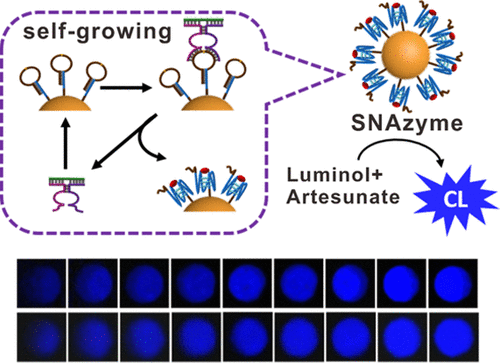Our official English website, www.x-mol.net, welcomes your
feedback! (Note: you will need to create a separate account there.)
Target-Catalyzed Self-Growing Spherical Nucleic Acid Enzyme (SNAzyme) as a Double Amplifier for Ultrasensitive Chemiluminescence MicroRNA Detection.
ACS Sensors ( IF 8.2 ) Pub Date : 2019-12-09 , DOI: 10.1021/acssensors.9b01655 Lin Shi 1 , Yudie Sun 1 , Lan Mi 1 , Tao Li 1
ACS Sensors ( IF 8.2 ) Pub Date : 2019-12-09 , DOI: 10.1021/acssensors.9b01655 Lin Shi 1 , Yudie Sun 1 , Lan Mi 1 , Tao Li 1
Affiliation

|
Portable chemiluminescence (CL) imaging with a smartphone has shown a great promise for point-of-care testing of diseases, especially for acute myocardial infarction (AMI), which may occur abruptly. A challenge remains how to improve the imaging sensitivity that usually is several orders of magnitude lower than those of counterpart methodologies using the sophisticated equipment. Toward this goal, here, we report the target-triggered in situ growth of AuNP@hairpin-DNA nanoprobes into spherical nucleic acid enzymes (SNAzymes), which serve as both nanolabels and amplifiers for portable CL imaging of microRNAs (miRNAs) with an ultrahigh sensitivity comparable to that of the instrumental measurement under same conditions. A G-quadruplex (G4) DNA dense layer is dynamically produced on the gold nanocore via a DNAzyme machine-driven hairpin cleaving and captures the cofactor hemin to form the SNAzymes with higher peroxidase activity and stronger nuclease resistance than the commonly used G4 DNAzymes. The matured SNAzymes are then utilized as catalytic labels in a luminol-artesunate CL system for miRNA imaging with a smartphone as the portable detector. In this way, two AMI-related miRNAs, miRNA-499 and miRNA-133a, are successfully detected in real patients' serum with a naked eye-visualized CL change at 10 fM, showing a 5 order of magnitude improvement on the sensitivity of visualizing the same disease markers in clinical circulating blood as compared to the reported strategy. In addition, a good selectivity of our developed CL imaging platform is demonstrated. These unique features make it promising to employ this portable imaging platform for clinical AMI diagnosis.
中文翻译:

标靶催化的自生球形核酸酶(SNAzyme)作为超灵敏化学发光MicroRNA检测的双扩增子。
使用智能手机进行便携式化学发光(CL)成像已显示出对疾病进行即时诊断的广阔前景,尤其是对于可能突然发生的急性心肌梗塞(AMI)。如何提高成像灵敏度仍然是一个挑战,通常比使用复杂设备的相应方法要低几个数量级。为了实现这一目标,我们在此报告了目标触发的AuNP @发夹DNA DNA纳米探针在原位生长为球形核酸酶(SNAzymes)的过程,该酶既可作为纳米标签,又可作为超高分子量microRNA(miRNA)的便携式CL成像的放大器灵敏度可与相同条件下仪器测量的灵敏度相媲美。G-四链体(G4)DNA致密层是通过DNAzyme机器驱动的发夹切割过程在金纳米核上动态产生的,并捕获辅因子血红素,形成了SNAzymes,与常用的G4 DNAzyme相比,SNAzymes具有更高的过氧化物酶活性和更强的核酸酶抗性。然后将成熟的SNAzyme用作鲁米诺-青蒿琥酯CL系统中的催化标记,使用智能手机作为便携式检测器进行miRNA成像。通过这种方法,在真实患者的血清中成功检测到两个与AMI相关的miRNA,即miRNA-499和miRNA-133a,肉眼可见的CL变化为10 fM,显示可视化灵敏度提高了5个数量级。与报告的策略相比,临床循环血液中的疾病标记相同。此外,还展示了我们开发的CL成像平台的良好选择性。
更新日期:2019-12-11
中文翻译:

标靶催化的自生球形核酸酶(SNAzyme)作为超灵敏化学发光MicroRNA检测的双扩增子。
使用智能手机进行便携式化学发光(CL)成像已显示出对疾病进行即时诊断的广阔前景,尤其是对于可能突然发生的急性心肌梗塞(AMI)。如何提高成像灵敏度仍然是一个挑战,通常比使用复杂设备的相应方法要低几个数量级。为了实现这一目标,我们在此报告了目标触发的AuNP @发夹DNA DNA纳米探针在原位生长为球形核酸酶(SNAzymes)的过程,该酶既可作为纳米标签,又可作为超高分子量microRNA(miRNA)的便携式CL成像的放大器灵敏度可与相同条件下仪器测量的灵敏度相媲美。G-四链体(G4)DNA致密层是通过DNAzyme机器驱动的发夹切割过程在金纳米核上动态产生的,并捕获辅因子血红素,形成了SNAzymes,与常用的G4 DNAzyme相比,SNAzymes具有更高的过氧化物酶活性和更强的核酸酶抗性。然后将成熟的SNAzyme用作鲁米诺-青蒿琥酯CL系统中的催化标记,使用智能手机作为便携式检测器进行miRNA成像。通过这种方法,在真实患者的血清中成功检测到两个与AMI相关的miRNA,即miRNA-499和miRNA-133a,肉眼可见的CL变化为10 fM,显示可视化灵敏度提高了5个数量级。与报告的策略相比,临床循环血液中的疾病标记相同。此外,还展示了我们开发的CL成像平台的良好选择性。











































 京公网安备 11010802027423号
京公网安备 11010802027423号